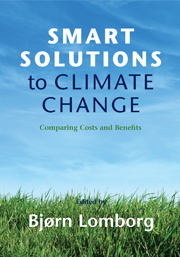Book contents
- Frontmatter
- Contents
- List of figures
- List of tables
- List of contributors
- Acknowledgments
- List of abbreviations and acronyms
- Introduction
- PART I THE SOLUTIONS
- 1 Climate Engineering
- 2 Carbon Dioxide Mitigation
- 3 Forestry Carbon Sequestration
- 4 Black Carbon Mitigation
- 5 Methane Mitigation
- 6 Market- and Policy-Driven Adaptation
- 7 Technology-Led Climate Policy
- 8 Technology Transfer
- PART II RANKING THE OPPORTUNITIES
- Conclusion
- Index
- References
2 - Carbon Dioxide Mitigation
Published online by Cambridge University Press: 05 June 2012
- Frontmatter
- Contents
- List of figures
- List of tables
- List of contributors
- Acknowledgments
- List of abbreviations and acronyms
- Introduction
- PART I THE SOLUTIONS
- 1 Climate Engineering
- 2 Carbon Dioxide Mitigation
- 3 Forestry Carbon Sequestration
- 4 Black Carbon Mitigation
- 5 Methane Mitigation
- 6 Market- and Policy-Driven Adaptation
- 7 Technology-Led Climate Policy
- 8 Technology Transfer
- PART II RANKING THE OPPORTUNITIES
- Conclusion
- Index
- References
Summary
Introduction
In the Copenhagen Consensus on Climate 2009 (hereafter, CCC09), options for climate policy are evaluated and ranked. The current chapter contributes with an analysis of five alternative policies to reduce carbon dioxide (CO2) emissions.
Ranking options is a standard tool of decision analysis (Pratt et al. 1995). It is important to note that options should be ranked on the basis of an internally consistent set of assumptions. That is done here for alternative ways to reduce CO2. By the same token, the CO2 options presented here cannot be readily compared to the other options for climate policy presented elsewhere in this forum as they are based on different assumptions with regard to (1) the future populations, economies, and emissions; (2) the working of the climate system; (3) the impact of climate change; (4) the impact of emission reduction; and (5) aggregation over space and time.
Although the chapter presents five options for CO2 emission reduction, the options differ only in scope and intensity. It is well known that a uniform carbon tax is the cheapest way to abate emissions (Weitzman 1974; Pizer 1997; Fischer et al. 2003). I therefore do not consider other policy instruments, as these necessarily have a lower benefit-cost ratio (BCR) than the options analyzed here.
The chapter proceeds as follows. The next section presents a rather lengthy review of the literature on the economic impacts of climate change, as this is a crucial and controversial part of any analysis of climate policy.
- Type
- Chapter
- Information
- Smart Solutions to Climate ChangeComparing Costs and Benefits, pp. 74 - 113Publisher: Cambridge University PressPrint publication year: 2010
References
- 6
- Cited by



